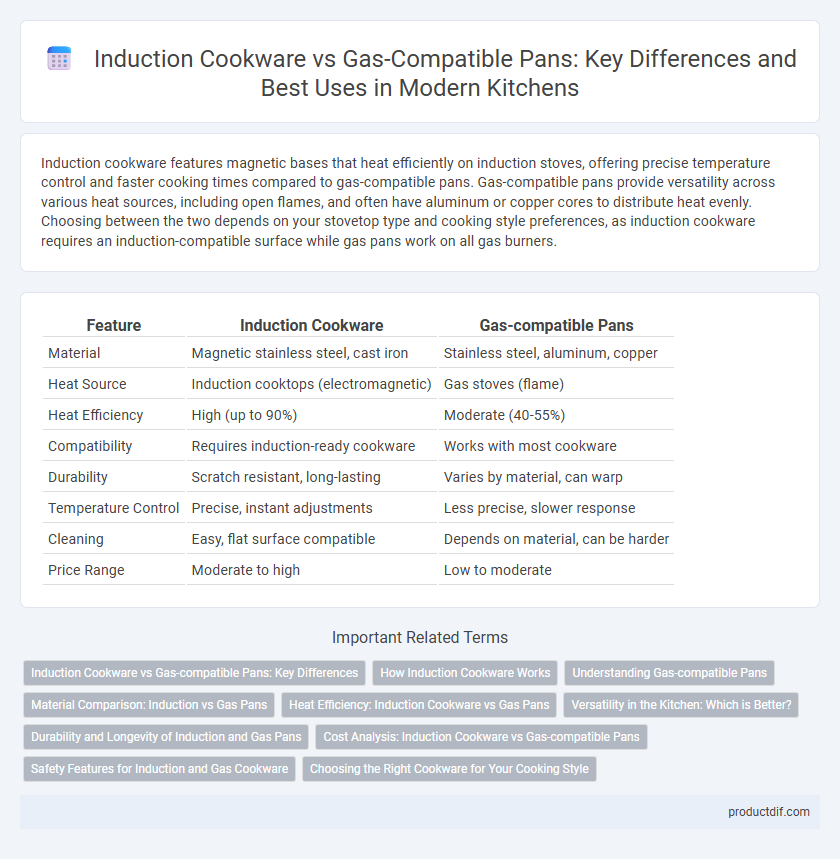Induction cookware features magnetic bases that heat efficiently on induction stoves, offering precise temperature control and faster cooking times compared to gas-compatible pans. Gas-compatible pans provide versatility across various heat sources, including open flames, and often have aluminum or copper cores to distribute heat evenly. Choosing between the two depends on your stovetop type and cooking style preferences, as induction cookware requires an induction-compatible surface while gas pans work on all gas burners.
Table of Comparison
| Feature | Induction Cookware | Gas-compatible Pans |
|---|---|---|
| Material | Magnetic stainless steel, cast iron | Stainless steel, aluminum, copper |
| Heat Source | Induction cooktops (electromagnetic) | Gas stoves (flame) |
| Heat Efficiency | High (up to 90%) | Moderate (40-55%) |
| Compatibility | Requires induction-ready cookware | Works with most cookware |
| Durability | Scratch resistant, long-lasting | Varies by material, can warp |
| Temperature Control | Precise, instant adjustments | Less precise, slower response |
| Cleaning | Easy, flat surface compatible | Depends on material, can be harder |
| Price Range | Moderate to high | Low to moderate |
Induction Cookware vs Gas-compatible Pans: Key Differences
Induction cookware features magnetic bases that allow efficient heat transfer via electromagnetic fields, making them faster and more energy-efficient compared to gas-compatible pans that rely on open flames. Gas-compatible pans offer versatility across various stovetops but often exhibit uneven heating and slower cooking times. The choice between induction cookware and gas-compatible pans hinges on stovetop type compatibility, heat control precision, and energy consumption preferences.
How Induction Cookware Works
Induction cookware operates through electromagnetic fields generated by the cooktop, which induce electric currents directly within the magnetic materials of the pan, causing it to heat efficiently and evenly. Unlike gas-compatible pans that rely on open flames for heat transfer, induction cookware requires a ferromagnetic base to function effectively, making materials like stainless steel and cast iron ideal. This technology offers rapid heating, precise temperature control, and energy efficiency, distinguishing it from traditional gas cooking methods.
Understanding Gas-compatible Pans
Gas-compatible pans feature a robust metal base, often made from stainless steel or cast iron, designed to withstand direct flame without warping. These pans deliver rapid heat distribution and precise temperature control essential for gas stovetops, enhancing cooking performance. Choosing gas-compatible cookware ensures durability and efficiency when using traditional open flames in kitchen environments.
Material Comparison: Induction vs Gas Pans
Induction cookware typically features magnetic stainless steel or cast iron materials that provide rapid heat transfer and consistent cooking temperatures. Gas-compatible pans often use aluminum or copper cores with stainless steel or nonstick surfaces, offering excellent heat conductivity and precise flame control. The key difference lies in induction materials requiring magnetic properties for compatibility, while gas pans prioritize thermal distribution and durability across open flames.
Heat Efficiency: Induction Cookware vs Gas Pans
Induction cookware offers superior heat efficiency by using electromagnetic energy to heat pans directly, reducing energy loss compared to gas-compatible pans that rely on an open flame. Gas pans often experience significant heat dispersion, resulting in longer cooking times and uneven temperature control. Induction cooktops can reach desired temperatures faster and maintain consistent heat, enhancing overall cooking performance.
Versatility in the Kitchen: Which is Better?
Induction cookware offers superior versatility by providing rapid, even heating and compatibility with energy-efficient induction cooktops, making it ideal for precise temperature control and various cooking techniques. Gas-compatible pans excel with their universal compatibility across all stovetops, including traditional gas burners, enabling high-heat cooking and quick responsiveness for tasks like searing and stir-frying. Choosing between induction and gas-compatible pans depends on your kitchen's heat source and culinary preferences, as induction pans suit modern, energy-saving setups while gas pans offer broader usability and adaptability.
Durability and Longevity of Induction and Gas Pans
Induction cookware typically features magnetic stainless steel or cast iron, making it highly durable and resistant to warping and corrosion over time. Gas-compatible pans often use materials like aluminum or copper with non-stick coatings that may degrade faster under high heat and direct flame exposure. Overall, induction pans tend to offer longer longevity, maintaining their performance and structural integrity through frequent use and cleaning.
Cost Analysis: Induction Cookware vs Gas-compatible Pans
Induction cookware tends to have a higher upfront cost due to the need for magnetic materials like stainless steel or cast iron, whereas gas-compatible pans offer a wider price range, including more affordable options like aluminum and non-magnetic stainless steel. Energy efficiency of induction cooktops reduces long-term cooking expenses by using electromagnetic energy directly, which lowers utility bills compared to gas stoves that lose heat to the environment. When analyzing durability and replacement frequency, induction-grade cookware generally lasts longer, potentially offsetting the initial investment and making it a cost-effective choice over time.
Safety Features for Induction and Gas Cookware
Induction cookware offers enhanced safety features such as automatic shut-off when no pan is detected, preventing accidental burns and energy waste. In contrast, gas-compatible pans require careful handling of open flames, increasing the risk of fire hazards and gas leaks if not used properly. Magnetic induction cooktops also maintain cooler surfaces during cooking, reducing the chance of burns compared to the exposed heat of gas burners.
Choosing the Right Cookware for Your Cooking Style
Choosing the right cookware depends on your cooking style and heat source compatibility. Induction cookware requires magnetic materials like cast iron or stainless steel with a ferromagnetic base, ensuring rapid and even heating for precise temperature control. Gas-compatible pans, often made from aluminum, copper, or stainless steel, provide versatile heat distribution and quick responsiveness, ideal for high-heat searing and traditional stovetop cooking methods.
Induction Cookware vs Gas-compatible Pans Infographic

 productdif.com
productdif.com